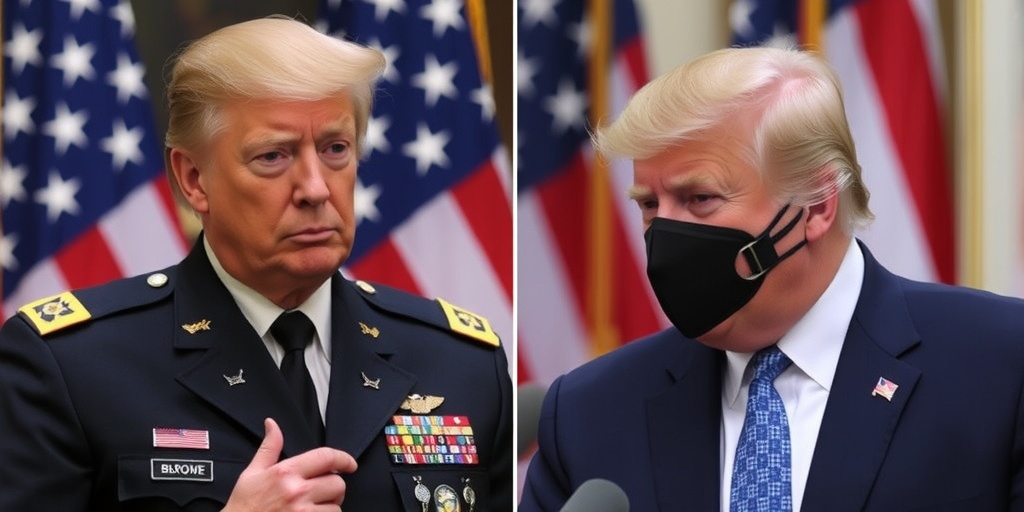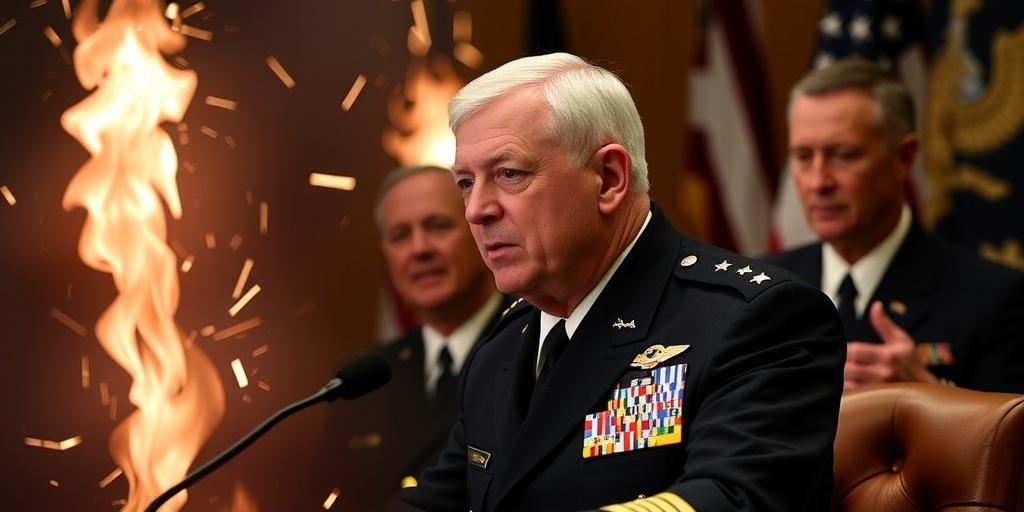Now Reading: Trump’s Firing of Gen. Brown Linked to George Floyd Protests
-
01
Trump’s Firing of Gen. Brown Linked to George Floyd Protests
Trump’s Firing of Gen. Brown Linked to George Floyd Protests

Title: Tensions Rise Between Trump and Military Leadership Following General Brown’s Dismissal
The killing of George Floyd by a police officer in May 2020 marked a significant turning point in American society, igniting widespread protests and a renewed focus on racial justice. This incident not only deeply impacted the public but also created fractures in the relationship between President Trump and senior military leaders, a theme that resurfaces with the recent dismissal of General Charles Q. Brown Jr., the chairman of the Joint Chiefs of Staff.
In a surprising move, President Trump terminated General Brown’s position during a late-night purge at the Pentagon. The president did not provide a public explanation for his action. At the time, General Brown was engaged with one of Trump’s key policy objectives at the U.S.-Mexico border. However, insiders suggest that the dismissal was influenced by a video General Brown had recorded in response to Floyd’s death. In that four-minute clip, he candidly shared his experiences as an African American pilot in the Air Force, reflecting on the systemic racism that exists within both society and the military.
The repercussions of George Floyd’s death have been significant, notably damaging the relationship between Trump and General Brown’s predecessor, General Mark A. Milley. In the days following Floyd’s murder, General Milley was seen accompanying Trump on a controversial walk across Lafayette Square, which occurred after law enforcement had forcibly cleared out peaceful protesters. This optics-driven event drew considerable backlash, with many criticizing Milley for involving the military in a politically charged situation. The general later publicly apologized for his participation, stating, “I should not have been there,” which reportedly infuriated Trump, leading to a rift between the two.
Tensions escalated further as General Milley and then-Defense Secretary Mark Esper strongly opposed Trump’s calls to invoke the Insurrection Act, which would allow the deployment of active-duty troops in response to the protests. Following these events, Trump’s trust in both men deteriorated, ultimately leading to Esper’s termination via a tweet. Milley’s situation worsened to the point where Trump publicly suggested that he should face dire consequences.
Even after Trump returned to power, the residual effects of these events were evident as portraits of both Milley and Esper were removed from the Pentagon. General Brown’s position remains precarious; while Trump has not explicitly criticized him, he is reportedly seeking to replace Brown with the retired three-star Lt. Gen. Dan Caine. There is growing speculation around whether Brown will receive a portrait commemorating his tenure as Joint Chiefs chairman.
The military’s handling of diversity has come under fire during this controversial period. Pete Hegseth, Trump’s newly appointed Secretary of Defense, has previously questioned whether General Brown’s ascension to his position was due to racial considerations rather than merit. Hegseth’s comments have pointedly cast doubt on Brown’s qualifications, framing the debate around race rather than capability.
General Brown’s powerful four-minute video, released on June 4, 2020, resonated with many within the military community. His heartfelt message outlined the dual realities faced by African American service members, including his own experiences of being one of the few Black individuals in his career. He spoke candidly about the emotional weight he carried and the challenges he faced with identity and acceptance, both in and out of the uniform. He articulated the struggles of living in a society where systemic racism persists and addressed the doubts regarding his authenticity as a Black officer among peers.
The gravity of Brown’s message carried significant weight, especially during a time of national turmoil over racial injustice. He thought about the implications of his role as the first African American nominated to lead the Air Force and acknowledged the expectations tied to his position amidst a predominantly white leadership structure in the military.
With President Biden’s administration, General Brown was appointed as chairman of the Joint Chiefs of Staff, marking a historic moment as the Pentagon was led by two Black men—General Brown and Secretary of Defense Lloyd J. Austin III. Nonetheless, Trump’s perspective towards Brown remained unchanged after the powerful video, and, ultimately, he was dismissed despite his declaration to faithfully execute the lawful orders of the president.
Alongside General Brown, other notable military leaders faced the consequences of the evolving political landscape, as Admiral Lisa Franchetti, the first woman to lead the Navy, and General James Slife, who had prompted airmen to reflect on institutional racism, were also let go. Political analysts highlight that these abrupt actions raise numerous questions about leadership, accountability, and the future of military conduct in politically charged atmospheres.
As the nation continues to grapple with issues of equality and justice, the intersection of military leadership and racial dynamics remains a crucial conversation as evidenced by the unfolding events in the Trump administration. The dismissal of General Brown signifies not just a change in military leadership but also reflects ongoing societal tensions that continue to shape the future of America.
Stay Informed With the Latest & Most Important News
Previous Post
Next Post
-
 01New technology breakthrough has everyone talking right now
01New technology breakthrough has everyone talking right now -
 02Unbelievable life hack everyone needs to try today
02Unbelievable life hack everyone needs to try today -
 03Fascinating discovery found buried deep beneath the ocean
03Fascinating discovery found buried deep beneath the ocean -
 04Man invents genius device that solves everyday problems
04Man invents genius device that solves everyday problems -
 05Shocking discovery that changes what we know forever
05Shocking discovery that changes what we know forever -
 06Internet goes wild over celebrity’s unexpected fashion choice
06Internet goes wild over celebrity’s unexpected fashion choice -
 07Rare animal sighting stuns scientists and wildlife lovers
07Rare animal sighting stuns scientists and wildlife lovers




















